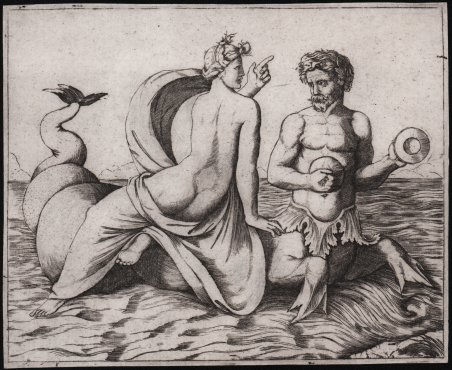Tritone che nuota nel mare tenendo i cimbali in entrambe le mani; una Nereide, che gesticola con la mano sinistra, a cavallo della sua schiena. Bulino, 1517-30 circa, privo di firma ed indicazioni editoriali. Incisione attribuita ad Agostino de Musi, da un affresco della bottega di Raffaello (Urbino 1483-Roma 1520) o, come suggerisce Bartsch, a Marcantonio Raimondi. Esemplare del primo stato di due, prima dell'indirizzo di Losi. Questa stampa venne catalogata da Ruland (1876) come opera di Agostino Veneziano e come riferibile a un elemento decorativo della Loggia Vaticana, progettata da Raffaello ed eseguita dalla sua bottega (1517-19 circa) in Vaticano; potrebbe forse essere riferita a una parte ormai perduta della decorazione di una colonna esterna, elemento riprodotto anche in una successiva stampa di Cherubino Alberti. La sequenza ripetuta della decorazione delle Logge è fortemente influenzata dall'antico; Raffaello aveva studiato scultura e pittura antiche a Roma. Agostino de Musi, detto Agostino Veneziano, nacque in Veneto, forse a Venezia, intorno al 1490, periodo fissato approssimativamente dagli studiosi in base alle date più antiche incise su alcune stampe. Si recò a Roma nel 1515/16, dove entrò in rapporto con Marcantonio Raimondi, divenendone, insieme a Marco Dente, uno dei principali alfieri e poi collaboratori nella "ditta" Raimondi, la prima vera e propria impresa artistico-commerciale impegnata nella riproduzione di soggetti raffaelleschi. Ad un periodo, fino al 1520, di intensa attività della bottega di Marcantonio seguirono probabilmente anni più difficili dovuti alla morte di Raffaello nel 1520 e all'imprigionamento dello stesso Raimondi intorno al 1523-24 per aver inciso alcuni soggetti lascivi. ' Il sacco di Roma del 1527 spinse il De Musi a lasciare la città, verso Mantova, attratto da Giulio Romano. La produzione incisoria di Agostino è assai vasta e consistente numericamente, soprattutto se rapportata al breve arco di tempo in cui fu realizzata, all'incirca tra il 1514 e il 1536. Alle 139 incisioni riportate dal Bartsch sono da aggiungere le nuove 4 citate dal Passavant e le 8 riportate dallo Heinecken: si tratta di bulini tutti firmati o contrassegnati dal monogramma, a volte costituito da lettere normali, a volte da caratteri gotici; a queste opere sono da aggiungere anche un gruppo di circa 60 bulini anonimi di probabile o dubbia attribuzione. Bellissima impressione su sottile carta vergata coeva, rifilata al rame o con margini sottili, in ottimo stato di conservazione. Un'opera molto rara. Bibliografia Bartsch, Le Peintre graveur (XIV.154.228); Ruland, C., 1876. The Works of Raphael Santi da Urbino as represented in the Raphael Collection in the Royal Library at Windsor Castle, formed by the Prince Consort, 1853-1861 and completed by Her Majesty Queen Victoria, Weimar – Ruland p. 232 B.131. Triton swimming in the sea holding cymbals in both a hands with a Nereid, gesturing with her left hand, riding on his back. Engraving, circa 1517-30, attributed to Agostino de Musi after a work by the workshop of Raphael (Urbino 1483-Rome 1520) or, as Bartsch suggests, to Marcantonio Raimondi. Example of the first state of two, before Losi address. A print depicting a triton and a nereid catalogued by Ruland (1876) as by Agostino Veneziano and as related to a design element in the Loggia Vaticana, designed by Raphael and executed by his workshop (c.1517-19) in the Vatican; it may perhaps be related to a now lost part of the decoration on an exterior pilaster, another element of which is reproduced in a print by Cherubino Alberti. The repeating sequence of decoration in the Logge, is strongly influenced by the antique; Raphael had studied antique sculpture and painting in Rome. Agostino de Musi, known as Agostino Veneziano, was born in the Veneto, possibly in Venice, around 1490, a period set approximately by scholars based on the earliest dates engraved on some prints. He went to Rome in 1515/16, where he entered into a relationship with Marcantonio Raimondi, becoming, along with Marco Dente, one of his principal pupil and later collaborators in the Raimondi “firm,” the first real artistic-commercial enterprise engaged in the reproduction of Raphaelesque subjects. A period, until 1520, of intense activity in Marcantonio's workshop was probably followed by more difficult years due to Raphael's death in 1520 and the imprisonment of Raimondi himself around 1523-24 for engraving some lascivious subjects. The Sack of Rome in 1527 prompted De Musi to leave the city, heading for Mantua, attracted by Giulio Romano. The collaboration with Giulio coincided with a period characterized by high artistic achievements and intense production, dating from the years 1530-1532. Agostino's engraving production is very large and numerically consistent, especially when compared to the short time span in which it was produced, roughly between 1514 and 1536. To the 139 engravings reported by Bartsch must be added the new 4 cited by Passavant and the 8 reported by Heinecken: these are all signed or monogrammed engravingss, sometimes consisting of normal letters, sometimes of Gothic characters; to these works must also be added a group of about 60 anonymous enrgavings of probable or doubtful attribution. A fine, early, impression on contemporary laid paper, trimmed to the platemark or with thin margins, excellent condition. A very rare work. Bibliografia Bartsch, Le Peintre graveur (XIV.154.228); Ruland, C., 1876. The Works of Raphael Santi da Urbino as represented in the Raphael Collection in the Royal Library at Windsor Castle, formed by the Prince Consort, 1853-1861 and completed by Her Majesty Queen Victoria, Weimar – Ruland p. 232 B.131. Cfr.

Découvrez comment utiliser
Découvrez comment utiliser

